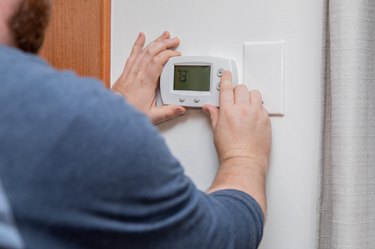
A White-Rodgers heat pump thermostat is basically an Emerson thermostat because Emerson acquired White-Rodgers in 1961. It has all the same terminal connections as any brand of thermostat, and when you're wiring it to your heat pump system, the requirements of your system determine how to do it.
Most of the wiring is straightforward and the same as any single-stage thermostat controlling a heating or cooling system. A heat pump is a special case, however, because it may or may not also function as a cooling system (most do). If it does, it has a reversing valve to change the direction of the refrigerant running through the system. On some models, this valve has to be open when cooling is selected, and on some models, it has to be closed. You have to know which is which to wire the thermostat correctly.
Video of the Day
Video of the Day
Besides this, there are other specialized functions to connect, such as emergency heating, that your system may or may not have. You can usually figure out your system characteristics by reading the owner's manual, but if not, you're better off having a pro do the wiring. That way, you'll be sure your heating and cooling system will operate as expected.
Basic White-Rodgers Thermostat Wiring
Thermostat wires are color coded, and many (but not all) of the thermostat terminals are labeled with the first letter of the wire that goes there. Here are the ones you'll find on all 24-volt thermostats:
- The red wire supplies power to the thermostat and connects to the R terminal. White-Rodgers thermostats often have two R terminals, Rh and Rc, and they are usually bonded with a jumper wire. If your system controls a heating system and cooling system independently, which is rare, you'll have two red wires. If so, remove the jumper and connect one wire to each terminal. Otherwise, leave the jumper there.
- The black wire is the return power wire, and it connects to the C terminal. "C" stands for common.
- The green wire controls the circulation fan. It connects to the G terminal.
Wiring Heat Pump Functions
Most heat pumps provide cooling as well as heating, and when both functions are present, the thermostat needs separate wires to control each of them.
- The white wire connects to the W terminal. It's the wire that sends the signal for first-stage heating.
- The yellow wire connects to the Y terminal. It's the wire that sends the signal for first-stage cooling.
- The W2 and Y2 terminals are for second-stage heating and cooling, respectively. There are no standard colors for the wires that connect to these terminals. If you're replacing an old thermostat, they'll be connected to the W2 and Y2 terminals on that thermostat. If you just have a bunch of wires sticking out of the wall and they aren't labeled, you'll need an HVAC pro to help you distinguish them.
- The E terminal is for emergency heat, and that wire also has no standard color. You need this terminal, which may also be labeled AUX (for auxiliary) if your system has a resistive heating element to provide emergency heat.
Connecting the Reversing Valve
On a White-Rodgers heat pump thermostat, you'll see two other terminals, one labeled B and one labeled O. You will use one of these but not both, and to determine which one, you'll have to read your manual so you know how your system works.
In most systems, the reversing valve is turned on when the system is in cooling mode, and in this case, you use the B terminal. You should find a blue wire to connect to it. If the reversing valve has to be off when the system is in cooling mode, use the O terminal. There should be an orange wire to connect to it.